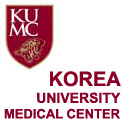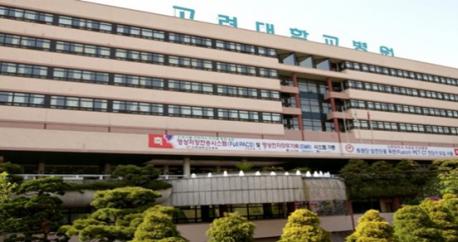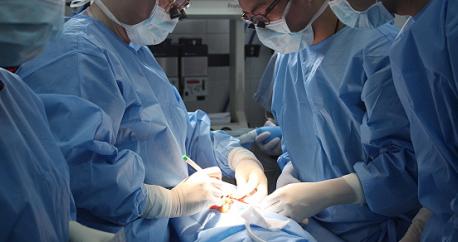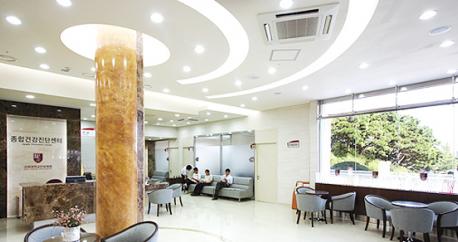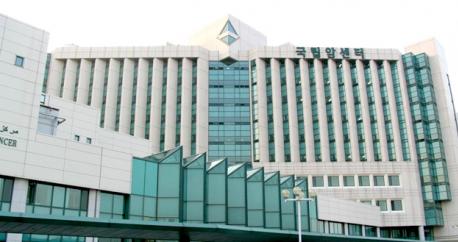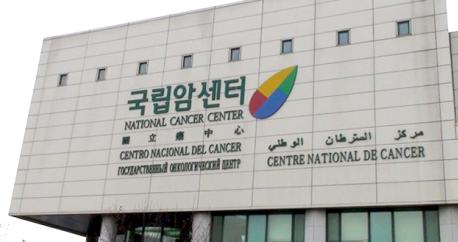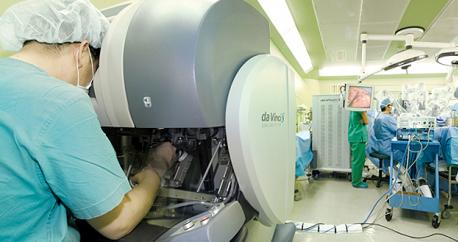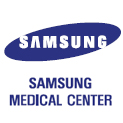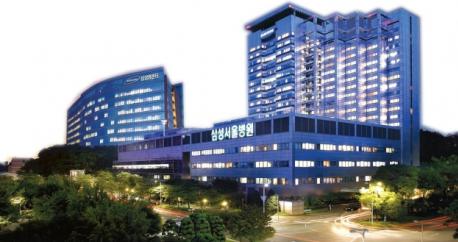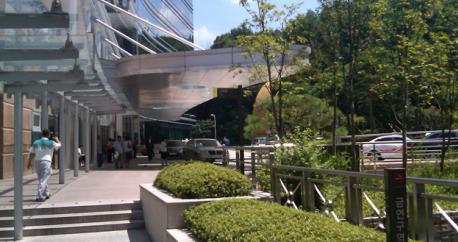A variety of tumors can be occurred in the head and neck. Largely, it divided into benign and malignant tumors. Benign tumors often means a lump and malignant tumors means a cancer. Benign tumors usually grow very slowly and it is almost cured by simple excision surgery but malignant tumors can lose their lives if it is not treated well in the early stage so that early diagnosis and positive treatment are needed. As the cancer occurred in the head and neck, there are laryngeal cancer, pharyigeal cancer, mouth cancer, esophagus cancer, salivary gland cancer, thyroid cancer and maxillary sinus. If it is progressed, it is metastasized to the lymph nodes of neck so that it can be appeared by the mass of cervical area. Malignant tumors is proceeded by surgery, radiation therappy and anti-cancer medicine.
Head & Neck Cancer
A variety of tumors can be occurred in the head and neck. Largely, it divided into benign and malignant tumors. Benign tumors often means a lump and malignant tumors means a cancer. Benign tumors usually grow very slowly and it is almost cured by simple excision surgery but malignant tumors can lose their lives if it is not treated well in the early stage so that early diagnosis and positive treatment are needed. As the cancer occurred in the head and neck, there are laryngeal cancer, pharyigeal cancer, mouth cancer, esophagus cancer, salivary gland cancer, thyroid cancer and maxillary sinus. If it is progressed, it is metastasized to the lymph nodes of neck so that it can be appeared by the mass of cervical area. Malignant tumors is proceeded by surgery, radiation therappy and anti-cancer medicine.
Symptoms of Head & Neck Cancer
- 1. Dental: Halitosis, oral dryness, efflorescence, chronic ulcers and pain, oral mass (lump)
- 2. Sinus-nasal : nasal congestion, headache, bloody nasal discharge (bloody nose), olfactory disorders
- 3. Salivary glands: pain when chewing, palpable mass(lump) in both down the chin and below ear
- 4. Thyroid: Palpable mass (lump) in front of the neck, hoarseness, weight loss
- 5. Pharyngeal: Difficulty in swallowing (swallowing hardship), dysphagia (pain when swallowing), chronic
- 6. Ulcers : Palpable mass(lump) in the neck
- 7. Larynx: Wheezing, hoarseness, airway obstruction, shortness of breath
Diagnosis of Head & Neck Cancer
1. Diagnostic radiographic examination
Simple chest photos, neck simple picture, esophagogram, upper gastrointestinal shooting and mammography shooting are selectively performed, if necessary, computed tomography (CT) or magnetic resonance imaging (MRI) scans may be done.
2. Endoscopy and biopsy
After the result of percutaneous fine needle aspiration, in case that malignant tumors came out, or not, endoscopic examination is performed if a tumor has a long history of smoking or drinking a patient comes to long-term, In this case, observation of the nasopharyngeal, larynx, esophagus and bronchus is essential. It is usually performed under general anesthesia and biopsy is performed and the diagnosis is confirmed if the lesion is observed. If lesion is not seen, biopsy will be made empirically on the part occurred frequently.
3. Ultrasound
It is simply performed as a noninvasive test and can be useful for the differentiation of vascular lesions, inherent diseases, solid tumors and cystic lesion.
4. Magnetic resonance imaging
The same video is expressed as computed tomography scan and define exactly the extent of infiltration of soft tissue of the mass(lump) in the T-2 video.
5. Remote transfer test
Chest radiography, liver ultrasound and bone scan are performed in order to check whether cancer is spreading or not in the organs of whole body such as lung, liver and bone.
6. Open biopsy
Biopsy of cervical tumors is directly performed by using open method if primary location is not detected even if above tests are performed in the patients with about 5% cervical cancer. At this point, the neck dissection is often performed, depending on the results of biopsy and in case that it was revealed as the lymph nodes cancer, anti-cancer medicine therapy is performed. In case that it was revealed as an inflammatory lesions, bacteriological examination and antibiotic are used.
Treatment of Head & Neck Cancer
1. Surgery
Surgery is performed under general anesthesia and blood test, urine test, chest radiology and electrocardiography in the outpatients are performed as a basic test for general anesthesia. After the result in one week, they will be hospitalized. Surgery time, in case of thyroid cancer, it takes about 3-4 hours for the recovery and anesthesia induction, it takes about 1-2 hours more. In case of the surgery of thyroid cancer, the patients will be hospitalized for one week and they can go back to home in 2 weeks, depending on the type of surgery.
2. Radiation therapy
Radiation therapy can be treated for about 6 weeks in home, without hospitalization. Early laryngeal cancer, thyroid cancer, lymphoma cancer and nasopharyngeal cancer are used as the primary treatment. It is supplementary performed in advanced cancers after the surgery.
3. Chemotherapy
In case of the last stage 3 and 4 what the possibilities of reoccurrence is high with only topical therapy, treatment outcomes are improved with the development of useful anti-cancer medicine.
4. Combination therapy
Method using in combination with chemotherapy or radiotherapy before or after surgery, is the most reasonable.
KMH Recommended Tips
Head and neck cancer, when the following symptoms, it should get necessarily medical care.
- 1. The voice change lasting more than six weeks
- 2. oral uclers, anasarca, red and white spot of oral mucosa not healing more than three weeks
- 3. When the difficulties of swallowing lasting longer than three weeks, When one side nose is blocked or when abnormal discharge is accompanied, When it is difficult to explain the cause, in case that teeth are vibrated regardless of dental disease. When there is the inflammation of the neck lasting longer than three weeks When the fullness of one side of the ear lasting longer than three weeks
If these symptoms occurr, you will be diagnosed through biopsy, if it's possible, after receiving the medical care of medical specialist of dental surgery.
Thyroid Cancer
The thgland is one of the endocrine organs and its role is to send it to blood as needed after saving and producing the thyroid hormone. It called thyroid nodules or thyroid tumors throughout the mass caused dueyroid to a variety of reasons and it is divided into benign and malignant tumor malignant and the malignant tumor of these means cancer.
Cause and provoking factors of Thyroid Cancer
Radiation exposure, family history, previous thyroid disease(goiter, benign thyroid nodules), hormonal factors, iodine deficiency, high-calorie diet, obeisity and etc.
Symptoms of Thyroid Cancer
In most cases, there are no symptoms and the most common symptoms of thyroid cancer is the mass of neck with no pain, and it is often found by chance by himself or others, or by a physician when physical examination. Signs or symptoms of thyroid cancer are likely to include the following:
- If the nodules are large or larger suddenly In case of the difficulties of breathing and in swallowing food by pressing the esohagus or airway because nodules are large.
- When the change of voice stays together with lump in the thyroid gland - Nodules does not move well because it got stuck in surrounding tissues.
- When you touch hard nodules
- Lymph nodes in the same side as nodules are touched
- In the family has thyroid cancer and when thyroid nodules are touched
- Under 20 years of age or when more than 60 years
Diagnosis of Thyroid Cancer
Fine Needle Aspiration Cytology
As observed by ultrasound and the test what pathologist examine under the microscope after sampling from the cells and vesicular fluid from the thyroid nodule using a very thin needle.
Thyroid Function Tests
The test to measure the concentrations of thyroid hormones in the blood, calcitonin and thyroid-related substance
3) Thyroid Ultrasound
4) Thyroid Scan
It is performed to see possibilities of recurrence and metastasis after the surgery of thyroid gland by deciding the size, location and type of thyroid gland using radioactive iodine and using the principles what thyroid is intakes iodine.
5) Neck CT and PET
Treatment of Thyroid Cancer
1) Radioactive Iodine Therapy
It is the treatment method performed in case of possibilities of distant metastatic or invasion of pericolic tissue from patients who received thyroidectomy.
2) External Beam Irradiation
It is to examine the metastatic other parts of the neck or thyroid cancer by using high-energy radiation machines. This is a topical treatment method to treat the only part for radiation therapy is shoot.
3) Chemotherapy
It refers to treatment used anti-cancer medicine which destruct cancer cells by stopping growth or proliferation affecting cell growth in cycles to treat cancer cells.
4) Thyroid Hormones Therapy
5) Surgical Treatment
- ① Thyroid resection
The most common method of ways of thyroid cancer as a surgery removing the whole (bilobectomy and isthmus) of thyroid tissue - ② Subtotal thyroid
It is the method of removing the rest remaining the part of the thyroid tissue is to remove all. - ③ Thyroidectomy
It is performed exceptionally in case of the age of patients is young with smaller initial papillary carcinoma as a surgery removing lobes of the side what cancer invaded and in case of benign tumors, it is often performed.
Endoscopic Thyroidectomy
endoscopic patients who can receive endoscopic surgery are limited and it is performed only in case that size is small and surrounding tissues or lymp node metastasis does not have, as a surgery method through part(chest, arm and etc.) which is not visible from the outside without hurting neck through endoscopic surgery.
Da Vinci Robotic Surgery
Surgery is performed after controlling robot arm by seeing the image what doctor in the cockpit of outside magnified as a surgery method used robotic surgery recently introduced. You can check structures exactly by enlarging the part of surgery and sophisticated surgery is possible by adjusting the trembling of doctor’s hands compared to direct surgery. Beauty effect is good because surgical incision is small.
KMH Recommended Tips
- Conduct of regular medical examination
- If you are overweight or obese, the risk of occurrence is high so that you keep maintaining healthy weight through diet and proper exercise.
- The effort to minimize exposure of hazardous materials is required when working exposed to hazardous substances.
- Eating more fruits and vegetables and avoid the excessive intake of animal fat.
- Please consult sufficiently with medical staff to understand coping skills about side effects or complications after the treatment and surgery.
- You can live a normal life except for surgery and radioactive iodine treatment period and also will not affect your career.
- There might be having a variety of ups and downs in emotion of cancer patients ranging from the stage of cancer diagnosis. You have to know related information in order to get professional help as needed for the management of emotional change and mental stress.
- Examination of body state all the time by visiting hospital regularly and being fully aware note related to treatment in addition to this.
